高中英语教师资格证听说课教案
高中英语教师资格证考试科目三听说课教案
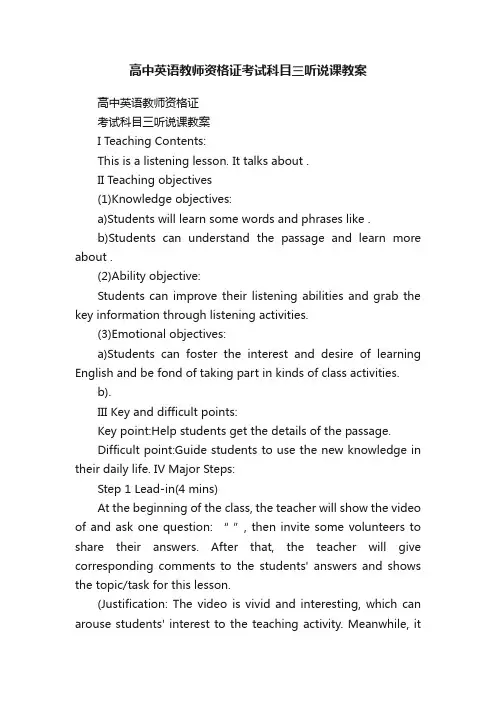
高中英语教师资格证考试科目三听说课教案高中英语教师资格证考试科目三听说课教案I Teaching Contents:This is a listening lesson. It talks about .II Teaching objectives(1)Knowledge objectives:a)Students will learn some words and phrases like .b)Students can understand the passage and learn more about .(2)Ability objective:Students can improve their listening abilities and grab the key information through listening activities.(3)Emotional objectives:a)Students can foster the interest and desire of learning English and be fond of taking part in kinds of class activities.b).III Key and difficult points:Key point:Help students get the details of the passage.Difficult point:Guide students to use the new knowledge in their daily life. IV Major Steps:Step 1 Lead-in(4 mins)At the beginning of the class, the teacher will show the video of and ask one question: “ ”, then invite some volunteers to share their answers. After that, the teacher will give corresponding comments to the students' answers and shows the topic/task for this lesson.(Justification: The video is vivid and interesting, which can arouse students' interest to the teaching activity. Meanwhile, itcan also lead to the topic today naturally)Step 2 Pre-listening(5 mins)1.PredictionBefore listening, the teacher will guide students to make a prediction. The teacher will present some hints to help them.Hint 1: Title of this material- .Hint 2: Some pictures/ videos in which students can see .2.Words/Phrases explanationThe teacher will explain some new and d ifficult words/ phrases l ike.Students will use those words to make sentences. (Justification: Through above activities, students will be prepared to listen and can understand the material better)Step 3 While-listening(20 mins)1.Extensive listeningStudents will listen to the passage for first time to check their prediction and conclude the main idea of the passage.(Justification: Through extensive listening, students will havea general understanding of this passage.)2.Intensive listeningStudents should listen to the passage for the second time and do the following tasks: (1)True or False(T/F).(T/F).(T/F).(2)Matching/ Form-filling/Mind mapping(Justification: Through above listening activities, students will not only understand the main idea and details of this listening material, but also improve their listening ability. )Step 4 Post-listening(11 mins)Group discussion/Do a survey:Students will work in groups to discuss the following question/ do a survey about: ?After the discussion, several students will be invited to share their answers. Then the teacher will make a conclusion.(Justification: This task can arouse students’ interest and involve the whole class. Also, by group discussion, students' critical thinking and autonomous learning ability can be developed. /They will be more confident to share their opinions in public./ They will be willing to cooperate with others.) Step5 Summary and homework(5 mins)1.SummaryAsk students to act as an assistant teacher to conclude what we have learned this class. Then make a summary together.(Justification:Reviewing the important knowledge in this lesson can deepen students' impression and form good study habits.)2.Homework(1)Retell the passage after the class.(2)Search more information about and share with others next class. (Justification: Retelling can help students sort out the course content, while the task of collecting information can help students actively explore more knowledge and information.)。
高中英语试讲听说教案模板
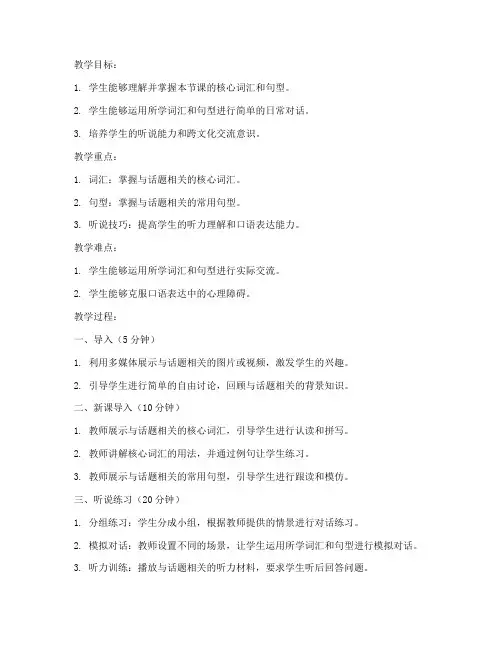
教学目标:1. 学生能够理解并掌握本节课的核心词汇和句型。
2. 学生能够运用所学词汇和句型进行简单的日常对话。
3. 培养学生的听说能力和跨文化交流意识。
教学重点:1. 词汇:掌握与话题相关的核心词汇。
2. 句型:掌握与话题相关的常用句型。
3. 听说技巧:提高学生的听力理解和口语表达能力。
教学难点:1. 学生能够运用所学词汇和句型进行实际交流。
2. 学生能够克服口语表达中的心理障碍。
教学过程:一、导入(5分钟)1. 利用多媒体展示与话题相关的图片或视频,激发学生的兴趣。
2. 引导学生进行简单的自由讨论,回顾与话题相关的背景知识。
二、新课导入(10分钟)1. 教师展示与话题相关的核心词汇,引导学生进行认读和拼写。
2. 教师讲解核心词汇的用法,并通过例句让学生练习。
3. 教师展示与话题相关的常用句型,引导学生进行跟读和模仿。
三、听说练习(20分钟)1. 分组练习:学生分成小组,根据教师提供的情景进行对话练习。
2. 模拟对话:教师设置不同的场景,让学生运用所学词汇和句型进行模拟对话。
3. 听力训练:播放与话题相关的听力材料,要求学生听后回答问题。
四、课堂展示(10分钟)1. 学生分组进行对话展示,教师进行点评和指导。
2. 邀请个别学生进行口语表达展示,教师进行点评和鼓励。
五、总结与作业(5分钟)1. 教师对本节课所学内容进行总结,强调重点和难点。
2. 布置课后作业,要求学生运用所学知识进行听说练习。
教学反思:1. 教师在课堂上应注重激发学生的学习兴趣,提高学生的参与度。
2. 教师应关注学生的个体差异,因材施教,使每个学生都能在课堂上有所收获。
3. 教师应注重培养学生的听说技巧,提高学生的口语表达能力。
4. 教师应关注学生的心理需求,帮助学生克服口语表达中的心理障碍。
教学资源:1. 课件:与话题相关的图片、视频、听力材料等。
2. 词汇卡片:用于展示和练习核心词汇。
3. 话题情景图:用于模拟对话和听力训练。
教资高中英语科目三教案听力
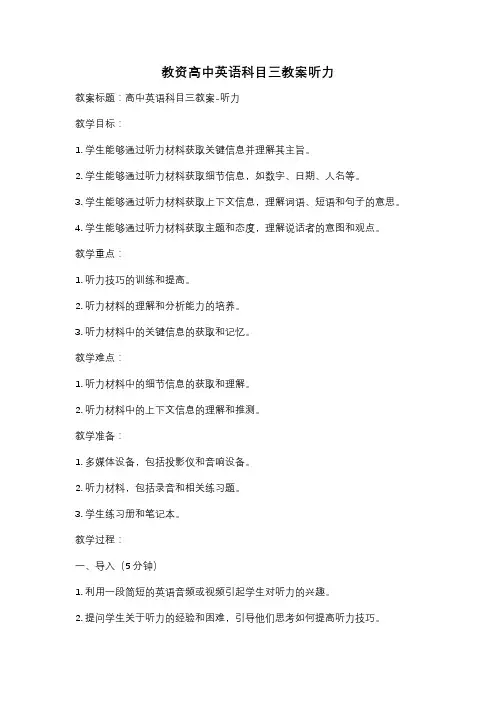
教资高中英语科目三教案听力教案标题:高中英语科目三教案-听力教学目标:1. 学生能够通过听力材料获取关键信息并理解其主旨。
2. 学生能够通过听力材料获取细节信息,如数字、日期、人名等。
3. 学生能够通过听力材料获取上下文信息,理解词语、短语和句子的意思。
4. 学生能够通过听力材料获取主题和态度,理解说话者的意图和观点。
教学重点:1. 听力技巧的训练和提高。
2. 听力材料的理解和分析能力的培养。
3. 听力材料中的关键信息的获取和记忆。
教学难点:1. 听力材料中的细节信息的获取和理解。
2. 听力材料中的上下文信息的理解和推测。
教学准备:1. 多媒体设备,包括投影仪和音响设备。
2. 听力材料,包括录音和相关练习题。
3. 学生练习册和笔记本。
教学过程:一、导入(5分钟)1. 利用一段简短的英语音频或视频引起学生对听力的兴趣。
2. 提问学生关于听力的经验和困难,引导他们思考如何提高听力技巧。
二、听力训练(30分钟)1. 播放一段听力材料,要求学生仅听一遍,并回答与材料相关的问题。
2. 学生自主检查答案,并与同桌讨论和比较。
3. 教师给出答案,并解释正确答案的依据和推理过程。
4. 分析听力材料中的关键信息和细节,引导学生注意听力技巧的应用和训练。
三、听力理解(15分钟)1. 播放一段较长的听力材料,要求学生听完后回答一系列问题,包括主旨、细节和上下文信息。
2. 学生独立完成问题,并与同桌讨论和比较答案。
3. 教师给出答案,并解释正确答案的依据和推理过程。
4. 引导学生分析听力材料中的上下文信息,推测词语、短语和句子的意思。
四、听力应用(15分钟)1. 播放一段听力材料,要求学生根据材料内容完成一项任务,如填写表格、写作摘要等。
2. 学生独立完成任务,并与同桌讨论和比较答案。
3. 教师给出范例答案,并解释正确答案的依据和推理过程。
4. 引导学生分析听力材料中的主题和态度,理解说话者的意图和观点。
五、小结与延伸(5分钟)1. 总结今天的听力训练内容和技巧,强调学生在日常生活中的听力应用。
高中英语听说课教案模板(共6篇)
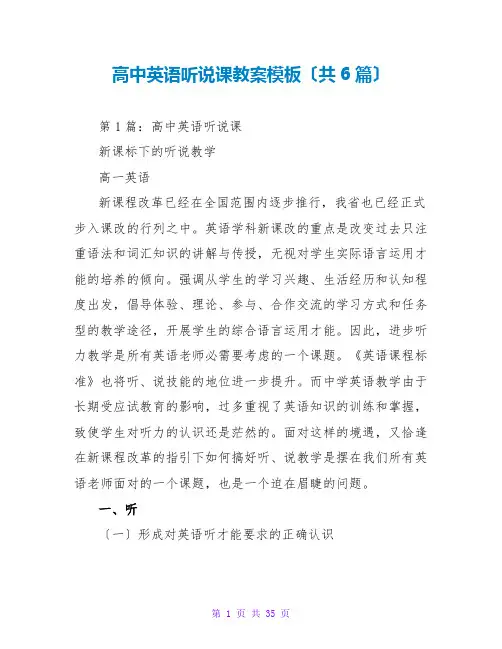
高中英语听说课教案模板〔共6篇〕第1篇:高中英语听说课新课标下的听说教学高一英语新课程改革已经在全国范围内逐步推行,我省也已经正式步入课改的行列之中。
英语学科新课改的重点是改变过去只注重语法和词汇知识的讲解与传授,无视对学生实际语言运用才能的培养的倾向。
强调从学生的学习兴趣、生活经历和认知程度出发,倡导体验、理论、参与、合作交流的学习方式和任务型的教学途径,开展学生的综合语言运用才能。
因此,进步听力教学是所有英语老师必需要考虑的一个课题。
《英语课程标准》也将听、说技能的地位进一步提升。
而中学英语教学由于长期受应试教育的影响,过多重视了英语知识的训练和掌握,致使学生对听力的认识还是茫然的。
面对这样的境遇,又恰逢在新课程改革的指引下如何搞好听、说教学是摆在我们所有英语老师面对的一个课题,也是一个迫在眉睫的问题。
一、听〔一〕形成对英语听才能要求的正确认识新课标逐年加大听力局部的分值。
目前,英语口试还不作一般考试的要求,所以,学生不会创造气氛去说英语。
基于这种情况,我们应努力让学生理解,好的听力不仅对笔试有帮助,它更是一种才能的表达,因为我们学英语的目的不是为了考试,考试是作为一种催促的手段,我们的目的是用英语来进展交际。
口头交流是最简单最普遍的交际方式。
而只有我们在听得懂别人说的话和说得出自己的观点时,我们才有交流。
所以说,听懂说好英语既是我们学习的目的,也是学习英语的根本要求。
〔二〕听前准备听前的准备工作是非常重要的,一般情况下老师只是留几分钟时间让学生自己看要答复的问题,或在多媒体课件上列出一些听力内容中的生词、词组后就让学生听了。
听完后直接对答案。
但对于那些内容较难的听力材料,我们除了做以上工作外还应该给学生讲解一些关于听力材料的背景知识,把它当作听前的热身。
可以先让学生们看问题和与它相对应的选项,在他们看完以后,我让他们猜想听力材料的大致内容。
多数同学猜不出来,少数能猜出来的同学也不敢答复。
这时可以在黑板上列出了以下一些【关键词】:^p 。
教资高中英语教案听力设计模板
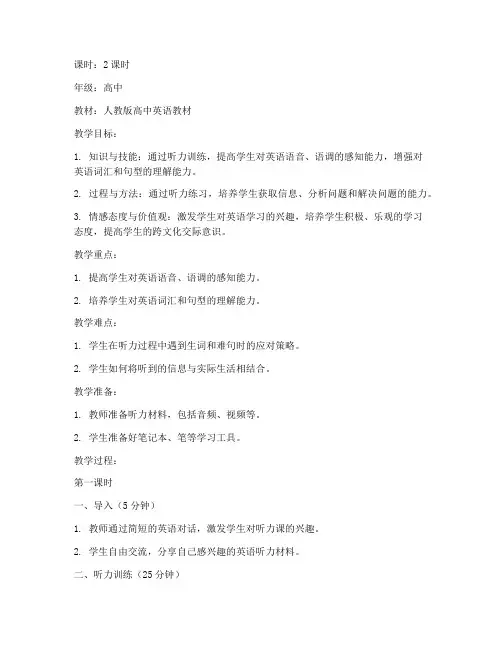
课时:2课时年级:高中教材:人教版高中英语教材教学目标:1. 知识与技能:通过听力训练,提高学生对英语语音、语调的感知能力,增强对英语词汇和句型的理解能力。
2. 过程与方法:通过听力练习,培养学生获取信息、分析问题和解决问题的能力。
3. 情感态度与价值观:激发学生对英语学习的兴趣,培养学生积极、乐观的学习态度,提高学生的跨文化交际意识。
教学重点:1. 提高学生对英语语音、语调的感知能力。
2. 培养学生对英语词汇和句型的理解能力。
教学难点:1. 学生在听力过程中遇到生词和难句时的应对策略。
2. 学生如何将听到的信息与实际生活相结合。
教学准备:1. 教师准备听力材料,包括音频、视频等。
2. 学生准备好笔记本、笔等学习工具。
教学过程:第一课时一、导入(5分钟)1. 教师通过简短的英语对话,激发学生对听力课的兴趣。
2. 学生自由交流,分享自己感兴趣的英语听力材料。
二、听力训练(25分钟)1. 教师播放第一篇听力材料,要求学生认真听并回答问题。
2. 学生完成听力练习后,教师带领学生分析答案,讲解听力技巧。
3. 教师播放第二篇听力材料,学生分组讨论,互相交流。
三、课堂小结(5分钟)1. 教师总结本节课的听力技巧和要点。
2. 学生分享自己在听力过程中的心得体会。
第二课时一、复习与巩固(10分钟)1. 教师播放上一节课的听力材料,让学生回顾并总结。
2. 学生分组讨论,分享自己的学习心得。
二、拓展训练(20分钟)1. 教师播放新的听力材料,学生独立完成听力练习。
2. 学生完成听力练习后,教师带领学生分析答案,讲解听力技巧。
三、课堂小结(5分钟)1. 教师总结本节课的听力技巧和要点。
2. 学生分享自己在听力过程中的心得体会。
四、课后作业(5分钟)1. 学生根据教师的要求,完成课后听力作业。
2. 教师提醒学生注意听力材料的多样性,提高听力水平。
教学反思:1. 教师在听力教学中,要注重培养学生的自主学习能力,提高他们的听力技巧。
教资高中英语听力教案模板
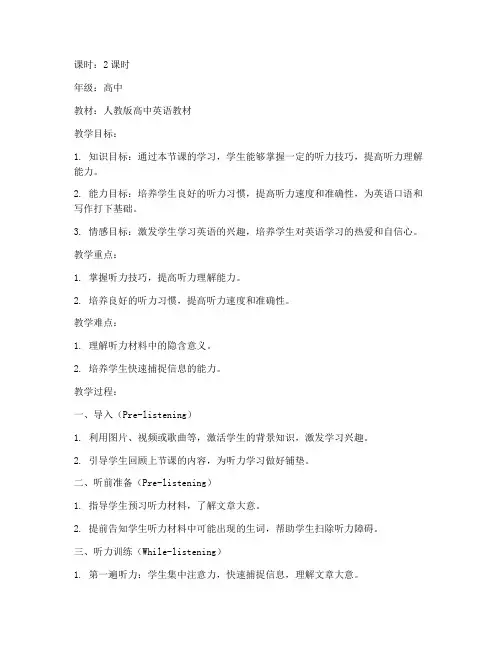
课时:2课时年级:高中教材:人教版高中英语教材教学目标:1. 知识目标:通过本节课的学习,学生能够掌握一定的听力技巧,提高听力理解能力。
2. 能力目标:培养学生良好的听力习惯,提高听力速度和准确性,为英语口语和写作打下基础。
3. 情感目标:激发学生学习英语的兴趣,培养学生对英语学习的热爱和自信心。
教学重点:1. 掌握听力技巧,提高听力理解能力。
2. 培养良好的听力习惯,提高听力速度和准确性。
教学难点:1. 理解听力材料中的隐含意义。
2. 培养学生快速捕捉信息的能力。
教学过程:一、导入(Pre-listening)1. 利用图片、视频或歌曲等,激活学生的背景知识,激发学习兴趣。
2. 引导学生回顾上节课的内容,为听力学习做好铺垫。
二、听前准备(Pre-listening)1. 指导学生预习听力材料,了解文章大意。
2. 提前告知学生听力材料中可能出现的生词,帮助学生扫除听力障碍。
三、听力训练(While-listening)1. 第一遍听力:学生集中注意力,快速捕捉信息,理解文章大意。
2. 第二遍听力:引导学生关注细节,理解文章结构,培养逻辑思维能力。
3. 第三遍听力:引导学生分析文章中的隐含意义,提高听力理解能力。
四、听力技巧讲解(Listening Skills)1. 分析听力材料,总结听力技巧,如:预测、抓关键词、听主旨大意等。
2. 举例说明听力技巧在听力训练中的应用。
五、听力练习(Listening Practice)1. 学生根据所学技巧,进行听力练习,巩固所学知识。
2. 教师巡视课堂,解答学生在练习过程中遇到的问题。
六、课堂小结(Summary)1. 回顾本节课所学的听力技巧,强调听力训练的重要性。
2. 指导学生课后进行听力练习,巩固所学知识。
七、作业布置(Homework)1. 完成教材中的听力练习,提高听力水平。
2. 收集英语听力材料,进行自主听力训练。
教学反思:1. 本节课通过多种教学手段,激发学生的学习兴趣,提高听力理解能力。
教师资格证考试-面试-高中英语-教案模板+逐字稿-听力课
教师资格证考试-面试-高中英语-教案模板+逐字稿-听力课【设计思路】听力课,我们采用PWP模式,即pre-listening、while- listening以及post- listening;各个环节可以设计的活动如下:Pre- listening:预测文章内容1st listening:获取文章大意PWP While- listening 2nd listening:获取文章细节内容3rd listening:检查细节内容Post- listening:复述文章内容/小组讨论/角色扮演【教案】Teaching PlanTeaching Aims:Knowledge aims:(1)Students can understand the meaning of the listening material.(2)Students will learn some knowledge about ….Ability aims:(1)Students can improve their listening abilities for general idea and detailed information.(2)Students can master their skills about how to introduce … in their own words.Emotional aims: (以下内容选一/二即可)(1)Students can get more interests and confidence in learning English.(2)Students will be willing to apply their English into daily use.(3)Students can get the awareness of cooperation with others.Teaching Key & Difficult Points:Teaching key point:Students can get a better understanding of the listening material.Teaching difficult point:Students will learn to use different listening abilities to deal with different information..Teaching Procedures:Step 1 Warming up1.Greetings.2.Lead-in: (以下导入方式选其一即可)①Review the knowledge that we learned before/in the last class with the students: …②Check students’ homework that I assigned in the last class: …③Share a story/saying/experience with students: …④Show students some pictures about … and ask them to think about the following questions:/ Play a short video to the students and ask them to think about the following questions during watching:Q1: …Q2: …⑤Free talk: ask students to discuss the following question and then invite some of them to share their answers:Q: …Step 2 Pre-listening (以下方式取其一即可)①Show students the title of the listening material and ask them to try to predict the what the listening material may talk about according to the title/the pictures on the screen.②Show students some words and expressions that appear in the listening material and ask them to predict what the passage may talk about according to these.Words and expressions: …③Ask students to think about the following questions and then invite two of them to share their ideas. Then ask them to predict what the passage may talk about.Q1: …Q2: …Step 3 While-listening(1)1st listening: ask students to listen to the material for the first time and try to catch the main idea of it.(2)2nd listening: ask students to listen to the material again, in order to answer the following questions/in order to tell the following statements true(T) or false(F)/in order to finish the chart on the screen.Questions/statements/chart: …(3)3rd listening: the teacher will read the material and ask students to check all the answers.(若材料比较难,可以设计此步骤,若材料比较简单,可在2nd listening中设计成教师朗读,但是若文章没有要求教师朗读,可省略此步骤)Step 4 Post-listening (以下方式选其一即可)①Ask students to retell the listening material according to the key details on the screen in their own words.②Ask students to discuss the following question in group of four and then share their ideas and give evaluation.Question: …③Role play the conversation.(一般对话形式的材料可以用此活动)Step 5 Summary and HomeworkSummary: ask a student/lead the students to summarize the content of this lesson.(总结环节可是老师自己总结,让同学总结,老师和同学一起总结三种方式,一般使用后两种方式比较好)Homework: ask students to search the Internet for more information about … and try to write a short passage to introduce it./ask students to finish the exercises on the book.Blackboard design:【试讲逐字稿】[自我介绍]:Good morning/afternoon, dear judges, I’m No.X candidate applying for high school English teacher. (有的地方不让说姓名,只能说号码,但有的地方规定要说姓名,进入面试室时,有人会给你看一下注意事项,所以请一定看清,否则说错了会视为作弊,取消资格的)(上面这一句是在敲门得到允许进去后,所做的自我介绍,或者是向考官问好,一般考官会回应说:good morning/afternoon,之后你需要走到讲台上,进行结构化答题,回答结束后,考官会说请开始你的试讲)分割线—下面是真正的试讲逐字稿Today my topic is …, now I’ll start my class.[Greetings]:Class begins, sit down please. Good morning/afternoon, boys and girls, welcome to my class. How are you guys today? Great? Not bad? Glad to hear that. Me? Oh I’m pretty good, thanks for your asking. So are you ready for our class? Ok, good.[Lead-in]:以下方式选其一即可(建议在此步骤中,若能与文章标题联系起来的时候,可以书写板书:具体的标题,若文章没有标题,可以找机会一边说:today we’re going to have a reading class, 一边书写板书:reading)①Before our class, boys and girls, let’s have a quick review about what we learned in the last class. Do you still remember it? Great, you all remember it. Yes, we learned about …. Now as for today we are going to learn more about it/we are going to learn another grammar.②Before our class, boys and girls, do you still remember the task that I assigned for you in the last class? Yes, it is … Ok, so how many of you have prepared it? Show me your hands. Ok Anna, please. (此处停顿几秒,假装Anna在回答)Excellent, I can see you did it with your heart. Now as for today, we are going to learn …/we are going to talk more about …③-1.Before our class, boys and girls, I’d like to share a story with you. After the story, you need to tell me …(此处可以出一个问题)So please listen to me carefully. … So who wants to share your answers with us? Anna, please. …(Anna的回答)Very good, sit down, please. Now as for today, we are going to learn …/we are going to talk more about …③-2.Before our class, boys and girls, I have s sentence for you, please listen to me carefully and please try to guess its meaning …(此处讲一个名人名言)So who wants to share your answers with us? Anna, please. …(Anna的回答)Very good, sit down, please. Now as for today, we are going to learn …/we are going to talk more about …③-3.Before our class, boys and girls, I’d like to share one experience of mine with you …(讲经历)So how about you? Do you have any unforgettable experience? Anna, please share with us. …(Anna的回答)Very good, sit down, please. Now as for today, we are going tolearn …/we are going to talk more about …④Before our class, boys and girls, let’s watch a short video/some pictures, and you need to think about the following questions: Q1: … and Q2: … Are you clear? Ok, great, let’s start here.(观看视频/图片,停顿几秒)Well you have enjoyed the video/the pictures, have you got the answers? Anna, you please. Oh you think … Yes, great, sit down please. How about question 2? Peter, please have a try. You think … I agree with you, sit down please. Now as for today, we are going to learn …/we are going to talk more about …⑤Before our class, boys and girls, I’d like to ask you a question: … Anna, please have a try. Yeah, …(Anna的回答)Wonderful, thank you, sit down please. And? Peter, please. Great, …(Peter的回答)Now as for today, we are going to learn …/we are going to talk more about …[Pre-listening]: 以下方式选其一即可①We’ll have a listening class, now I’ll give you the title of the material. As now we know the title of the listening material, so can you try to guess what the listening material may talk about? I heard that it may talk about … Wonderful! We’ll see whether you’re right or not inthe following listening part.(如果文章比较难,可以提问学生;注意此处的预测的只是文章的大概内容,并不是文章大意)②Now, let’s look at the words and expressions on the screen, they’re from this listening material. Do you know the meaning of them? You all know? Very good. Ok now please try to guess what the passage may talk about? You can discuss it with your partners first, then share with us, clear? Ok, start here.(停顿几秒)Time’s up. Who wants to try? Don’t be shy, just to have a try, ok? Elsa, please. …(Elsa的回答)Good, sit down please. Do you agree with her? Yes? No? Well let’s check her answer in the following reading.(如果文章比较简单,提问一人即可,若比较难,可以提问两个学生;另外,如果单词比较难,需要简单的讲解下)(注意此处的预测的只是文章的大概内容,并不是文章大意)③Now look at the following two questions on the screen. You can discuss them with your partners first and then share your answers with us. Ok, start here.(停顿几秒)Time’s up. Who wants to try? Don’t be shy, just to have a try, ok? How about Elsa? …(Elsa的回答)That’s excellent, thank you and sit down please. And question 2? David, please have a try. …(David的回答)Great, sit down, please. According to these two questions, I’m sure you’ll have a guess about what the passage may talk about in your heart, right? Ok, let’s check your answers in the following reading.[While-listening]:(1)Now let’s listen to the material for the first time. In this time, you don’t need to catch some detailed information, just listen and try to catch key words and then summarize the main idea of it, clear? Good, let’s start here.(停顿几秒,这时可以书写板书:1st listening: main idea)Ok, let’s stop here. Have you got the answer? Good, it’s very easy, right? You can answer me together. The passage tells us … Wonderful! (若文章比较难,也可请同学回答: Ok, any volunteers? Tom, please have a try. The passage is mainly about … Ok, sit down please. Do you agree with him? No? Mike do you have any supplement? Oh, it mainly talks about … Yes, both of you did a good job. Sit down please.)(2)Now let’s listen to it again. This time, you should listen carefully to fill in the blanks/toanswer the questions/to tell the following statements true or false/to finish the chart on the screen. you should take notes if necessary, clear? Ok, start.(此时可以书写板书:2nd listening: Q1: … Q2: …)Ok, it’s over. Have you got the answers? Ok, I’d like you to discuss youranswers with your partners, clear?(停顿几秒)Ok, time’s up. Now I need some students to share with us. Amy, the first one please. … Good job, sit down please. The second one? Elsa, you please. …very good, sit down please. You all did a good job in this part.(3)Now I’ll read the material for the third time, and in this time, try to check all the answersand pay attention to the pronunciation and intonation, ok?(此时可以书写板书:3rd listening: check,然后教师阅读材料)That’s all for the listening part.[Post-listening]:以下方式选其一即可①Ok, next I’d like you to retell the passage on your own words according to the key details on the screen. you’ll have 10 minutes to think about it, and you can discuss it with your partners first, and then share your answers with us, clear? Ok start here.(停顿几秒)Now who can have a try? Peter, I saw your hands, please come to the front. (不需要真正复述,只需停顿几秒,然后直接点评即可)Good, you have a good memory, thanks for your sharing, please come backto your seat. Anyone else? Anna, you please,. (不需要真正复述,只需停顿几秒,然后直接点评即可)Well down, you can organize the passage in such short time, you must be a good English writer. Thanks and please come back to your seat.②Ok, next let’s do a group discussion. Four students in one group and try to think about the following question: … Please discuss it with your group members first, and then share your ideas with us, you’ll be given 10 minutes. Let’s start here. (停顿几秒)Time’s up. Have you got any ideas? Share with us. Group one, who’s the representative? Ok Elsa, please come to the front and show us your idea. (不需要真正回答,只需停顿几秒,然后直接点评即可)Sounds that your idea are so reasonable. Thanks for your sharing and please come back to your seat. How about group 2? Oh Mike, please. Come on, be brave. (不需要真正回答,只需停顿几秒,然后直接点评即可)Good, I heard so many great ideas. Thanks for your sharing too. And please come back to your seat. Group 3 and group 4, you are all helpers, well done.(三组和四组就不必一一回答了,整体点评即可)③There’s the listening material on the screen, now let’s do a role play. Three students in one group, one acts as … another acts as … and the last one acts as … You can practice it with your partners first, then show it in front of us. During your performance, please pay attention to the facial expressions and body languages. Let’s start.(停顿几秒)Ok, I see that you have finished your practice, so now let’s show it. Any volunteers? Ok, Elsa, Anna and Peter, you three, please come to the front.(停顿几秒)Wow, your pronunciation is so great, thank you, please come back to your seat.(若材料为对话,可设计此活动,分组的人数与对话材料中的人物数保持一致)[Summary and homework]:How time flies! It’s time to make a summary. Let’s do it together. Today we havelearned … Yes, very good, and we also learned some listening strategies for general idea and detailed information. Ok good, we all did a good job in this class.(老师带领大家一起回答时,当说到重点时候,要有所停顿,因为我们需要做的是引导学生回答,而不是我们自己回答)Well, after class, I’d like you to search the Internet for more information about … and try to write a short passage to introduce it. Please finish it, we’ll share it in the next class, are you clear? Ok, great, that’s all for today’s class, goodbye class, see you next time.(若实在想不出些什么作业,就直接让学生完成课本后的练习题:Well, please turn your book to page 23, do you see the exercises? Ok, good, after class, please finish the exercise 1 and 2, and we’ll check the answers in the next class, are you clear? Ok, great, that’s all for today’s class, goodbye class, see you next time.)[结尾]:That’s all for my presentation, thank you![接下来就是答辩]。
高中英语教案听说万能模板
教学目标:1. 培养学生运用英语进行日常交流的能力。
2. 提高学生的听力理解和口语表达能力。
3. 增强学生的跨文化交际意识。
教学重点:1. 听懂日常生活中的对话和短文。
2. 能够用英语进行简单的日常对话。
3. 了解并掌握常用的英语口语表达和交际技巧。
教学难点:1. 学生在听力过程中对关键词汇的捕捉和理解。
2. 学生在口语表达中的流利性和准确性。
3. 学生在跨文化交际中的文化意识。
教学准备:1. 教师准备相关听力材料、口语练习材料和文化背景知识。
2. 学生准备笔记本、录音设备等。
教学过程:一、导入1. 用英语进行简单的问候和自我介绍,营造轻松的学习氛围。
2. 提问学生:“Do you like to communicate with others in English? Why or why not?” 引导学生思考英语口语交流的重要性。
二、听力训练1. 播放一段与日常生活相关的听力材料,如对话或短文。
2. 学生边听边做笔记,记录关键词汇和重要信息。
3. 教师提问,检查学生对听力材料的理解情况。
4. 学生复述听力材料的主要内容,提高口语表达能力。
三、口语练习1. 教师给出一个话题,如:“My favorite holiday”,引导学生进行头脑风暴,列出相关词汇和表达。
2. 学生两人一组,用英语进行对话练习,尝试用所学词汇和表达完成对话。
3. 教师巡回指导,纠正学生的发音、语法和表达错误。
4. 学生展示对话,全班进行点评和反馈。
四、文化背景知识1. 教师介绍与话题相关的文化背景知识,如节日、习俗等。
2. 学生讨论文化差异,提高跨文化交际意识。
五、总结与反思1. 教师总结本节课的学习内容,强调重点和难点。
2. 学生反思自己的学习过程,提出改进意见。
3. 教师布置课后作业,巩固所学知识。
教学评价:1. 课堂参与度:观察学生在课堂上的表现,如是否积极发言、是否主动参与练习等。
2. 听力理解能力:通过听力测试,了解学生对听力材料的理解程度。
英语听说课教资教案模板范文
一、教学目标1. 语言技能目标:学生能够听懂日常生活中的英语对话,并能用英语进行简单的口头交流。
2. 知识目标:学生能够掌握常用的英语口语表达方式和常用词汇。
3. 情感态度目标:培养学生对英语学习的兴趣,提高学生自信心,鼓励学生在课堂上积极参与。
二、教学重难点1. 教学重点:掌握日常生活中的英语口语表达方式和常用词汇。
2. 教学难点:学生在实际情境中运用英语进行口头交流。
三、教学过程1. 导入- 利用多媒体展示日常生活场景,激发学生的学习兴趣。
- 引导学生思考:在这样的场景下,我们应该用英语说什么?2. 听力训练- 播放一段日常生活场景的英语对话,让学生认真聆听。
- 提问:对话中出现了哪些词汇和表达方式?学生能否用英语复述对话内容?3. 口语练习- 教师根据听力内容,设计几个实际情境,让学生进行角色扮演。
- 学生分组练习,教师巡回指导,纠正发音和语法错误。
4. 词汇拓展- 教师展示一些与日常生活相关的英语词汇,引导学生学习。
- 学生跟读并模仿,加深对词汇的记忆。
5. 语法讲解- 教师讲解日常生活中的常用英语语法知识。
- 学生通过例句理解语法规则,并尝试运用到实际对话中。
6. 练习巩固- 学生进行小组练习,用所学词汇和语法知识进行对话。
- 教师点评,纠正发音和语法错误。
7. 小结作业- 总结本节课所学内容,强调重点和难点。
- 布置课后作业,要求学生用所学知识进行口语练习。
四、板书设计1. 课堂主题:英语听说课2. 词汇:日常生活相关词汇3. 语法:常用英语语法知识4. 教学目标:听懂日常生活中的英语对话,能用英语进行简单的口头交流五、教学反思1. 关注学生的学习兴趣,创设生动有趣的课堂氛围。
2. 注重培养学生的口语表达能力,鼓励学生在课堂上积极参与。
3. 加强对学生口语发音和语法的指导,提高学生的英语水平。
4. 定期进行教学反思,不断改进教学方法,提高教学质量。
高中英语教师资格证听说课教案
高中英语教师资格证听说课教案Revised on November 25, 2020听力:Inferring推断,gist listening主旨,listening for details,dictationModels:top-down model, down-top model, interactive model教案模板:TopicTeaching Aims:1.Knowledge aim: The students will be able to know something about...; learnsome new words and phrases.2.Ability aim: The students will be able to develop their listening abilities such aslistening for the gist, the specific information and predicting skills...3.Emotional aim: The students will be abl e to know that they should…/Teaching Key and Difficult Points:Teaching Aid: CAITeaching Procedures:1.Step 1: lead-inPlay the song “…” and ask students to talk something about it.2.Step 2: pre-listeningIntroduce…Go through the new words and phrases.3.Step 3: while-listeningAsk students to listen to the tape and then answer the questions: Who, When, Where, What.Listen to the tape again, ask students to choose the correct answers.Do the dictation.4.Step 4: post-listeningLet students discuss the story in pairs and then retell the story.5.Step 5: Summary (or consolidation)6.Step 6: HomeworkRecites the wordsDo another exercise about …on Page…Blackboard Design:T: Good afternoon, boys and girls. Welcome back to my class. I am so glad to see you again. How are you today Great! Now I will play a song for you, please listen carefully to the content.T: What a happy song! So what is this song aboutT: Exactly, holiday!T: How do you feel about holiday As we all know, winter holiday is coming. What are you going to do on holiday Sleep, watch TV, or travel with parents I see. It seems like all of you have had a plan.T: Well, today we will listen to a tape about holiday, but before the listening, let’s go through the new words and phrases first. ….(Who can make a sentence using this word ; Lily, can you guess the meaning of this word Good job; Anyone knows the meaning of this phrases Chris, have a try! Great, it’s very close to its meaning.; Who can translate this sentence into Chinese Yeah, Bob please.)T: Ok, so much for the news words and phrases. Now, listen to the tape carefully, and then answer following questions: Who When Where What happenedT: 读材料T: The first question, who can answer it in volunteer Oh, John please.T: Good! It’s…T: The second question, who want to try Tom, please.T: Great! ….T: Susan, can you answer the third questionT: Good job! It’s in….T: Who can answer the last question Don’t be shy, just have a try! VictoriaT: It’s a difficult question but you did very well. But to be more precise, she didn’t …, inst ead, she…T: Now, listen to the tape again and do the dictation.T: Let’s check your work one by one. Tom, you first!T: Perfect! …(原文第一句话)Cindy, next.T: Good, but you miss two words. It should be ….(原文第二句话) Next one, Stacey.T: Good job. Pay attention to the word “…”, it’s x-x-x-x-x. Next, Bob.T: Very good. …T: Now, who can be the first one to retell the story Great! Peter, please.T: Very good job. Anyone else Lily, please.T: Also great! This story is … I think all of you have understand this story. You guys did a very good job today. But still remember to practice more after class. So thehomework is to make a plan for your holiday and I will ask some students to share their plans next class.Ok, that's all for today's class. See you!口语:教案模板:TopicTeaching contents:Teaching Aims:1.Knowledge aim: The students will be able to know something about...; learnsome words and phrases to describe...2.Ability aim: The students will be able to express their opinion on …3.Emotional aim: The students will be able to speak English more confidently Teaching Key and Difficult Points:Teaching Aid: CAITeaching Procedures:1.Step 1: lead-inShow some pictures to the students and ask some questions: …2.Step 2: discussionAsk students to discuss…with their partner, then ask two students to report the results.3.Step 3: practicePresent some sentences of …, then ask students to read them.Do the role play in pairs using those sentences, then ask one pair to do the presentation.4.Step 4: interviewPlay an interview video about ... ask students to intimate the interview pattern the speakers use and interview their partners, then ask one pair to do the presentation.5.Step 5: Summary (or consolidation)Review the sentences that we can use when we talk about…6.Step 6: homeworkInterview your classmate about … using the sentences and interview skills we learn today.Blackboard Design:T:Hi, boys and girls. We are now living in a highly developed world, with advanced culture and highly developed civilizations. Look at this picture, what…T: yes, you are right, it’s…So w hat do you think about…Who can share his/her idea Ok, Lily, please.T: Great! … If you are…, what would you … Bob, can you share your opinion with usT: Good job! For sure, different people have different view. But have you ever thought what are the base of all the culture and civilizationsT: Oh, yes, they are based on those which were created by our great, great grandfathers lived a long, long time ago. No one exactly knows what they lived on, what were their housing and home decoration conditions, what kind of tools they usually used in their production activities, and what entertainment they had in their spare time. Anyway, we can imagine! So now, let’s divide into groups of four and, with the help of your imagination, discuss what kinds of food the early man ate, what their housing conditions and home decorations were like, what tools they made and what entertainment they had in their spare time. Then I’ll ask some of you to report the results to the whole class.T: Time is up. Who volunteer to report the result Come on, don’t be shy! Ok, Stacey, very good!T: nice thought! Who also want to try Aslan, please.T: very interesting!T: Now, please turn to page 72, look at the SPEAKING part. You should read it with your partner, then, do the roles play. (Teacher writes bb--middle)Making suggestions and giving advice:1. What can you suggest Maybe we/you could ……2. Can I ask you for some advice I suggest (that)……3. Can you help me decide That’s a good idea.4. What do you have in mind Well, but what about……Have you considered doing……T: OK, time is up. In our daily life, we often ask someone for advice when we can’t make a decision. On the other hand, we often give other advice if they come to us for help. How can we ask for and give advice in English Let’s look at the blackboard. There are several sentences about giving advice, please read it follow me.T: Make sure you can use these sentences when you are making suggestion. Who can give us a dialogue Any volunteersT: Susan, you please, you can choose one of the situation in speaking part.T: ExcellentT: So much for practice, now I will play an interview video of native speakers, please listen carefully and learn how they interview. Ok, video is over, I’ll give you several minutes to prepare, then I’ll ask someone to intimate the interview pattern the speakers use and interview their partners. Ok, are you ready Who want to try Kate, please. Who is your partner Peter Ok, go ahead.T: Very good job! But both of you are a little nervous, I think you can do better after more practice. I will ask another two students. Any volunteers Lily, your group, please.T: Nice. Now, the class is almost over, let’s review the sentences…T: All of you did a good job today. Next class, we will learn something about friends, so your homework is to interview your classmate about … using the sentences and interview skills we learn today.Ok, that's all for today's class. See you!。
- 1、下载文档前请自行甄别文档内容的完整性,平台不提供额外的编辑、内容补充、找答案等附加服务。
- 2、"仅部分预览"的文档,不可在线预览部分如存在完整性等问题,可反馈申请退款(可完整预览的文档不适用该条件!)。
- 3、如文档侵犯您的权益,请联系客服反馈,我们会尽快为您处理(人工客服工作时间:9:00-18:30)。
听力:Models:top-down model, down-top model, interactive model教案模板:TopicTeaching Aims:1.Knowledge aim: The students will be able to know something about...; learn some newwords and phrases.2.Ability aim: The students will be able to develop their listening abilities such aslistening for the gist, the specific information and predicting skills...3.Emotional aim: The students will be able to know that they should…/Teaching Key and Difficult Points:Teaching Aid: CAITeaching Procedures:1.Step 1: lead-inPlay the song “…” and ask students to talk something about it.2.Step 2: pre-listeningIntroduce…Go through the new words and phrases.3.Step 3: while-listeningAsk students to listen to the tape and then answer the questions: Who, When, Where, What.Listen to the tape again, ask students to choose the correct answers.Do the dictation.4.Step 4: post-listeningLet students discuss the story in pairs and then retell the story.5.Step 5: Summary (or consolidation)6.Step 6: HomeworkRecites the wordsDo another exercise about …on Page…Blackboard Design:T: Good afternoon, boys and girls. Welcome back to my class. I am so glad to see you again. How are you today? Great! Now I will play a song for you, please listen carefully to the content.T: What a happy song! So what is this song about?T: Exactly, holiday!T: How do you feel about holiday? As we all know, winter holiday is coming. What are you going to do on holiday? Sleep, watch TV, or travel with parents? I see. It seems like all of you have had a plan.T: Well, today we will listen to a tape about holiday, but before the listening, let’s go through the new words and phrases first. ….(Who can make a sentence using this word? ; Lily, can you guess the meaning of this word? Good job; Anyone knows the meaning of this phrases? Chris, have a try! Great, it’s very close to its meaning.; Who can translate this sentence into Chinese? Yeah, Bob please.)T: Ok, so much for the news words and phrases. Now, listen to the tape carefully, and then answer following questions: Who? When? Where? What happened?T: 读材料T: The first question, who can answer it in volunteer? Oh, John please.T: Good! It’s…T: The second question, who want to try? Tom, please.T: Great! ….T: Susan, can you answer the third question?T: Good job! It’s in….T: Who can answer the last question? Don’t be shy, just have a try! Victoria?T: It’s a difficult question but you did very well. But to be more precise, she didn’t …, instead, she…T: Now, listen to the tape again and do the dictation.T: Let’s check your work one by one. Tom, you first!T: Perfect! …(原文第一句话)Cindy, next.T: Good, but you miss two words. It should be ….(原文第二句话)Next one, Stacey. T: Good job. Pay attention to the word “…”, it’s x-x-x-x-x. Next, Bob.T: Very good. …T: Now, who can be the first one to retell the story? Great! Peter, please.T: Very good job. Anyone else? Lily, please.T: Also great! This story is … I think all of you have understand this story. You guys did a very good job today. But still remember to practice more after class. So the homework is to make a plan for your holiday and I will ask some students to share their plans next class. Ok, that's all for today's class. See you!TopicTeaching contents:Teaching Aims:1.Knowledge aim: The students will be able to know something about...; learn somewords and phrases to describe...2.Ability aim: The students will be able to express their opinion on …3.Emotional aim: The students will be able to speak English more confidentlyTeaching Key and Difficult Points:Teaching Aid: CAITeaching Procedures:1.Step 1: lead-inShow some pictures to the students and ask some questions: …2.Step 2: discussionAsk students to discuss…with their partner, then ask two students to report the results.3.Step 3: practicePresent some sentences of …, then ask students to read them.Do the role play in pairs using those sentences, then ask one pair to do the presentation.4.Step 4: interviewPlay an interview video about ... ask students to intimate the interview pattern thespeakers use and interview their partners, then ask one pair to do the presentation.5.Step 5: Summary (or consolidation)Review the sentences that we can use when we talk about…6.Step 6: homeworkInterview your classmate about … using the sentences and interview skills we learn today.Blackboard Design:T:Hi, boys and girls. We are now living in a highly developed world, with advanced culture and highly developed civilizations. Look at this picture, what…?T: yes, you are right, it’s…So what do you think about…?Who can share his/her idea? Ok, Lily, please.T: Great! … If you are…, what would you …? Bob, can you share your opinion with us? T: Good job! For sure, different people have different view. But have you ever thought what are the base of all the culture and civilizations?T: Oh, yes, they are based on those which were created by our great, great grandfathers lived a long, long time ago. No one exactly knows what they lived on, what were their housing and home decoration conditions, what kind of tools they usually used in their production activities, and what entertainment they had in their spare time. Anyway, we can imagine! So now, let’s divide into groups of four and, with the help of your imagination, discuss what kinds of food the early man ate, what their housing conditions and home decorations were like, what tools they made and what entertainment they had in their spare time. Then I’ll ask some of you to report the results to the whole class.T: Time is up. Who volunteer to report the result? Come on, don’t be shy! Ok, Stacey, very good!T: nice thought! Who also want to try? Aslan, please.T: very interesting!T: Now, please turn to page 72, look at the SPEAKING part. You should read it with your partner, then, do the roles play. (Teacher writes bb--middle)Making suggestions and giving advice:1. What can you suggest? Maybe we/you could ……2. Can I ask you for some advice? I suggest (that)……3. Can you help me decide? That’s a good idea.4. What do you have in mind? Well, but what about……Have you considered doing……?T: OK, time is up. In our daily life, we often ask someone for advice when we can’t make a decision. On the other hand, we often give other advice if they come to us for help. How can we ask for and give advice in English? Let’s look at the blackboard. There are several sentences about giving advice, please read it follow me.T: Make sure you can use these sentences when you are making suggestion. Who can give us a dialogue? Any volunteers?T: Susan, you please, you can choose one of the situation in speaking part.T: ExcellentT: So much for practice, now I will play an interview video of native speakers, please listen carefully and learn how they interview. Ok, video is over, I’ll give you several minutes to prepare, then I’ll ask someone to intimate the interview pattern the speakers use and interview their partners. Ok, are you ready? Who want to try? Kate, please. Who is your partner? Peter? Ok, go ahead.T: Very good job! But both of you are a little nervous, I think you can do better after more practice. I will ask another two students. Any volunteers? Lily, your group, please.T: Nice. Now, the class is almost over, let’s review the sentences…T: All of you did a good job today. Next class, we will learn something about friends, so your homework is to interview your classmate about … using the sentences and interview skills we learn today.Ok, that's all for today's class. See you!。
